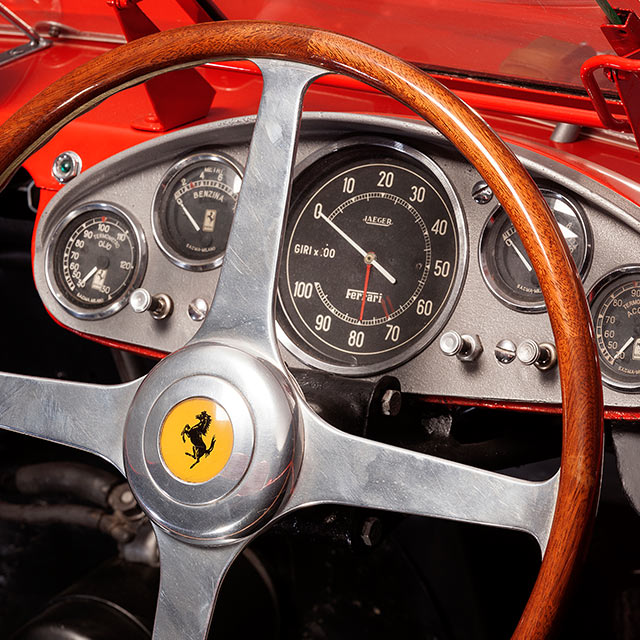Photography provided by Artcurial Motorcars
Why should we, as average enthusiasts, take notice of a car whose glory days are more than a half-century old? Is it because these cars don’t trade hands often, or that they’re immensely valuable?
I think it’s simple: as lovers of mechanical progression, we can’t deny the prowess behind the racers of yesteryear. Formulated in a time of extreme national pride, racing was a dangerous and courageous pastime. In the age of primitive wind tunnel aerodynamic development, mechanical engineering (Computers? Ha!) that was perpetually evolving, and when safety was more of an afterthought rather than a paramount requirement, it was cars like this Ferrari that made all successive cars better—not just Ferrari’s, but its competitors as well.
So take note not for the car’s place on race result spreadsheets, but because this Ferrari represents an era bygone. This car could do nearly 190 mph in 1957—that’s modern day road going supercar speeds—so if you wanted to take on the world’s best, this is the car you’d have to beat.


Completed in early 1957, this rosso 1957 Ferrari 335 S Scaglietti Spider was fitted with a 3.8-liter V12 that featured twin cams per cylinder head. Referred to in-house as the “Tipo 140,” this screaming Maranello masterpiece was able to churn out nearly 360 horsepower—better hp per liter than many modern performance cars—with some credit to whatever toxic fuel it was running on in period.
In March 1957, the “super” Spider was ready for its first event. With Peter Collins and Maurice Trintignant alternating behind its thin wood wheel, the two achieved sixth place overall at the Sebring 12 Hours endurance—a warm up run for what soon followed for chassis 0674.


Next, German driver Wolfgang (Alexander Albert Eduard Maximilian Reichsgraf Berghe) von Trips—what happened to names like that—was chosen to drive chassis 0674 for the 1957 Mille Miglia. The merciless 1,600 kilometer, non-stop sprint between the world’s fastest cars and most daring wheelmen ended with a one-two Ferrari win, with this car and Wolfgang von Trips finishing second behind Piero Taruffi—the two of the four Ferraris that had started.
After a successful Mille Miglia, the car returned to the factory for some reconditioning in preparation for even more challenging endeavors. The 3.8-liter was bored out to 4.1-litres, which subsequently demanded enough air through the twelve individual intake plenums to produce an estimated 400 horsepower—enough power for this prancing horse to gallop 300 kilometers per hour.

Scuderia Ferrari entrusted British racing car driver Mike Hawthorn and Italian pro Luigi Musso to helm the reworked Scaglietti steed at the 1957 24 Hours Of Le Mans. Nobly, the Englishman pushed the 335 S hard for the initial five hours until a catastrophic engine failure prevented Hawthorn from finishing the event. Yet, despite this disappointment the car ran the fastest lap and set a Le Mans record with an average speed of more than 126 mph (203 kph).
Again with the Hawthorn and Musso duo, chassis 0674 finished fourth at the Swedish Grand Prix and placed second at the Venezuela Grand Prix, which helped the Scuderia team earn the 1957 World Constructors’ Title. Shortly after, New York-based Ferrari importer Luigi Chinetti purchased the veteran racer for the 1958 season.
Gaston Andrey Motorsports founder Gaston Andrey then successfully raced the 355 Spider throughout the 1958 American racing season along with Lance Reventlow, founder of Scarab Motorsports—the latter obviously taking design influence from the Scaglietti’s pragmatic but graceful design.
Success soon followed, most notably on February 24, 1958: Stirling Moss and Maston Gregory won the Cuba Grand Prix—a first place win at last for 0647.




By 1960, the triumphant rosso racer was retired and purchased by Pennsylvanian architect Robert N. Dusek. Ten years later, the car was sold to Frenchman Pierre Bardinon, who’s housed and maintained this Maranello trophy-toting Spider for more than 40 years.
In its heyday, the Bardinon Collection specialized in obtaining only the most competitively successful and lust-worthy Maranello specimens—the world’s greatest Ferrari stable. Once questioned for the lack of historical collection at the Maranello factory, Enzo Ferrari boasted, “No need. Bardinon has done it for me.”
History
– Finished sixth at the 1957 Sebring 12 Hours (driven by Peter Collins and Maurice Trintignant)
– Finished second at the 1957 Mille Miglia (driven by Wolfgang von Trips)
– Set record lap time/speed at the 1957 24 Hours Of Le Mans (driven by Mike Hawthorn)
– Finished fourth at the 1957 Swedish Grand Prix (driven by Mike Hawthorn and Luigi Musso)
– Finished second at the 1957 Venezuela Grand Prix (driven by Mike Hawthorn and Luigi Musso)
– Won the 1957 season World Constructors’ Title for Ferrari
– Won the 1958 Cuba Grand Prix (driven by Maston Gregory and Stirling Moss)
– Cared for via the Pierre Bardinon Collection for more than 40 years
Specifications
“Tipo 140” 4.1-liter V12 (originally 3.8-liter prior to the 1957 24 Hour Of Le Mans)
Vehicle information
Chassis no.: 0674
Valuation
Auction house: The Retromobile Sale 2016
Estimate: $30,000,000-$34,000,000
Price realized: Auction on February 5/6
























































